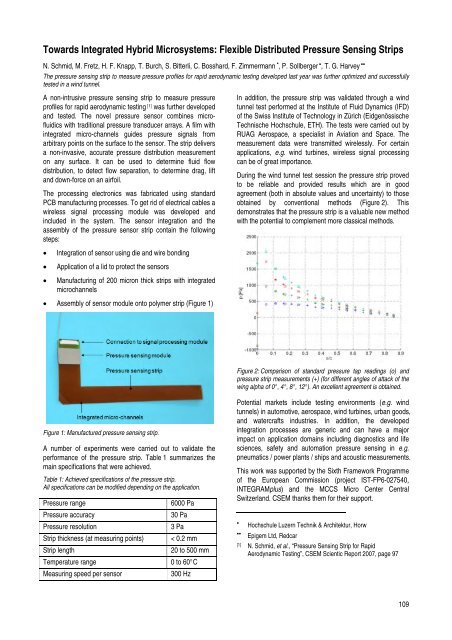CSEM Scientific and Technical Report 2008
CSEM Scientific and Technical Report 2008
CSEM Scientific and Technical Report 2008
Create successful ePaper yourself
Turn your PDF publications into a flip-book with our unique Google optimized e-Paper software.
Towards Integrated Hybrid Microsystems: Flexible Distributed Pressure Sensing Strips<br />
N. Schmid, M. Fretz, H. F. Knapp, T. Burch, S. Bitterli, C. Bosshard, F. Zimmermann • , P. Sollberger • , T. G. Harvey ••<br />
The pressure sensing strip to measure pressure profiles for rapid aerodynamic testing developed last year was further optimized <strong>and</strong> successfully<br />
tested in a wind tunnel.<br />
A non-intrusive pressure sensing strip to measure pressure<br />
profiles for rapid aerodynamic testing [1] was further developed<br />
<strong>and</strong> tested. The novel pressure sensor combines microfluidics<br />
with traditional pressure transducer arrays. A film with<br />
integrated micro-channels guides pressure signals from<br />
arbitrary points on the surface to the sensor. The strip delivers<br />
a non-invasive, accurate pressure distribution measurement<br />
on any surface. It can be used to determine fluid flow<br />
distribution, to detect flow separation, to determine drag, lift<br />
<strong>and</strong> down-force on an airfoil.<br />
The processing electronics was fabricated using st<strong>and</strong>ard<br />
PCB manufacturing processes. To get rid of electrical cables a<br />
wireless signal processing module was developed <strong>and</strong><br />
included in the system. The sensor integration <strong>and</strong> the<br />
assembly of the pressure sensor strip contain the following<br />
steps:<br />
• Integration of sensor using die <strong>and</strong> wire bonding<br />
• Application of a lid to protect the sensors<br />
• Manufacturing of 200 micron thick strips with integrated<br />
microchannels<br />
• Assembly of sensor module onto polymer strip (Figure 1)<br />
Figure 1: Manufactured pressure sensing strip.<br />
A number of experiments were carried out to validate the<br />
performance of the pressure strip. Table 1 summarizes the<br />
main specifications that were achieved.<br />
Table 1: Achieved specifications of the pressure strip.<br />
All specifications can be modified depending on the application.<br />
Pressure range 6000 Pa<br />
Pressure accuracy 30 Pa<br />
Pressure resolution 3 Pa<br />
Strip thickness (at measuring points) < 0.2 mm<br />
Strip length 20 to 500 mm<br />
Temperature range 0 to 60°C<br />
Measuring speed per sensor 300 Hz<br />
In addition, the pressure strip was validated through a wind<br />
tunnel test performed at the Institute of Fluid Dynamics (IFD)<br />
of the Swiss Institute of Technology in Zürich (Eidgenössische<br />
Technische Hochschule, ETH). The tests were carried out by<br />
RUAG Aerospace, a specialist in Aviation <strong>and</strong> Space. The<br />
measurement data were transmitted wirelessly. For certain<br />
applications, e.g. wind turbines, wireless signal processing<br />
can be of great importance.<br />
During the wind tunnel test session the pressure strip proved<br />
to be reliable <strong>and</strong> provided results which are in good<br />
agreement (both in absolute values <strong>and</strong> uncertainty) to those<br />
obtained by conventional methods (Figure 2). This<br />
demonstrates that the pressure strip is a valuable new method<br />
with the potential to complement more classical methods.<br />
Figure 2: Comparison of st<strong>and</strong>ard pressure tap readings (o) <strong>and</strong><br />
pressure strip measurements (+) (for different angles of attack of the<br />
wing alpha of 0°, 4°, 8°, 12°). An excellent agreement is obtained.<br />
Potential markets include testing environments (e.g. wind<br />
tunnels) in automotive, aerospace, wind turbines, urban goods,<br />
<strong>and</strong> watercrafts industries. In addition, the developed<br />
integration processes are generic <strong>and</strong> can have a major<br />
impact on application domains including diagnostics <strong>and</strong> life<br />
sciences, safety <strong>and</strong> automation pressure sensing in e.g.<br />
pneumatics / power plants / ships <strong>and</strong> acoustic measurements.<br />
This work was supported by the Sixth Framework Programme<br />
of the European Commission (project IST-FP6-027540,<br />
INTEGRAMplus) <strong>and</strong> the MCCS Micro Center Central<br />
Switzerl<strong>and</strong>. <strong>CSEM</strong> thanks them for their support.<br />
•<br />
Hochschule Luzern Technik & Architektur, Horw<br />
••<br />
Epigem Ltd, Redcar<br />
[1] N. Schmid, et al., “Pressure Sensing Strip for Rapid<br />
Aerodynamic Testing”, <strong>CSEM</strong> Scientic <strong>Report</strong> 2007, page 97<br />
109








